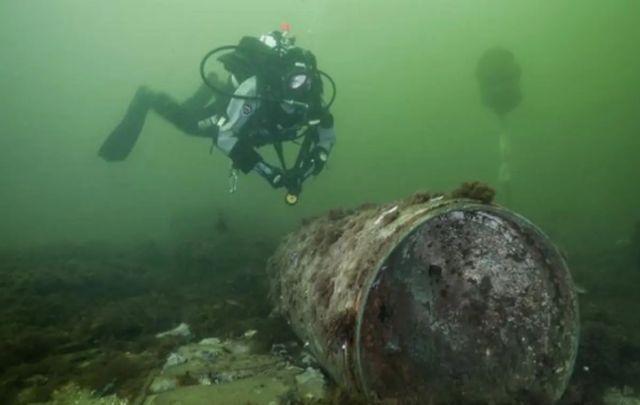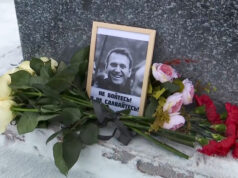On September 27, two explosions severely damaged Russia’s Nord Stream 1 and Nord Stream 2 pipelines near the Danish island of Bornholm, setting off wild speculation about possible sabotage.
Another two breaks in the pipeline, a tad to the north in Sweden’s Air Defense Identification Zone (ADIZ), were later identified but no explosions were reported. According to news sources citing Danish officials, each explosion was equivalent to 500 kilograms of TNT, the size of very large anti-shipping mines.
Not only the US Navy (together with its NATO allies) but also the Russian Navy conduct naval exercises in the Baltic Sea and many believe either the Russians or Americans are clandestinely responsible for the two blasts. Predictably enough, the two sides have blamed each other in loud and emphatic terms – without corroborating or credible evidence.
Unmentioned amid the incendiary speculation is the explosive condition of the Baltic seabed, which is loaded with dumped artillery shells, chemical weapons including Tabun nerve gas and mines. Under an agreement reached at the Potsdam Conference in 1945, Britain and the Soviet Union dumped approximately 69,000 tons of Germany’s chemical weapons stockpile into the Baltic Sea in 1947-48.
A second dumping in the same area took place in 1959. Moreover, during World War I and II, Germany laid some 80,000 sea mines including moored contact mines and constructor mines in the Baltic Sea, including around Bornholm. There are known to be Russian moored contact mines in the same area.
Overall, fewer than 200 mines have been located and exploded at sea. The fuses were removed from dumped chemical weapons but not necessarily from other munitions. The moored sea mines remain active.
Not all the munitions and chemical weapons, including nerve gas, remained where they were dumped and some of them were dropped short of their designated areas.
When the British dumped ammunition into the North Sea, they encased it in old ships, which they sank to prevent weapons from drifting on the seabed. This was not the case in the Baltic Sea, however.
Some weapons have washed ashore and signs of chemical contamination have been detected in Poland and elsewhere. Three Dutch fishermen were killed when they snared a mine and brought it up to the deck of their craft, where it detonated.
Engineers responsible for design work on the Nord Stream pipeline in 2005 were aware of the seabed’s littered circumstances, although all the exact dump sites were not known. A study completed prior to Nord Stream 1 found German mustard gas bombs 17 meters from the pipeline route and a fuse for a chemical bomb 16 meters from it.
A maximum effort was made to avoid known dump sites in laying the pipeline.
Nord Stream 1 was completed in 2011 while Nord Stream 2 began in 2018 following the same track around Bornholm Island (the lines are literally next to each other) and was completed in 2021.
Bornholm Island itself has a firing range and has been the site of military exercises. Last May, Colorado Army National Guard members teamed with active duty counterparts, US Air Force service members and international partners to conduct a simulated air-land raid during a M142 High Mobility Artillery Rocket Systems (HIMARS) rapid infiltration exercise, marking the first time HIMARS was deployed to Denmark.
HIMARS’ precision rockets have played an effective role in repelling the Russians in the Ukraine war. Putting HIMARS and its rockets’ 499-kilometer extended range at Bornholm would give NATO the ability to strike the vital Russian outpost of Kaliningrad, situated 363 kilometers away, in a war scenario.
In August and early September, the US Marines, led by the USS Kearsarge Amphibious Ready Group, conducted exercises in the Baltic Sea along with a number of American allies and friends. Air and sea operations took place adjacent to Bornholm Island, literally on top of the Nord Stream pipelines.
Could any of these military activities have resulted in disturbances on the seabed that caused the decades-old munitions buried there to explode? Were these air and sea missions conducted that involved anti-mining operations? Were unmanned underwater vehicles (UUVs) or other vehicles used in the recent military exercises?
Don’t answer those questions just yet.
Before the September 27 explosions, Russian military vessels were spotted in the same area. The names of the Russian ships operating there have not been released, nor have their exact locations.
Russia’s state-run TASS news service, however, reported on September 20 that the corvette Soobrazitelny of the Baltic fleet held an exercise with Ka-27PL antisubmarine helicopters to search for and destroy a hostile submarine.
The Russian corvette and helicopters searched for the submarine with radars and sonars and engaged antisubmarine weapons in the drill, according to the report. Typically, antisubmarine weapons are depth charges that unleash strong blasts near the sea bottom to try to destroy a lurking submarine.
The corvette also reportedly trained in destroying floating mines, setting up radio disturbances and launching artillery fire at sea and air targets, as well as in nuclear, biological and chemical protection and survivability.
Other countries have also been carrying out exercises in the sea. Poland announced Operation Redkin in the Baltic Sea on September 15, an exercise that ended three days later.
With all that visible military activity, it is safe to assume that secret operations were also conducted, including the likely use of submarines and UUVs and consistent shadowing of rivals’ naval operations.
All this now-frantic military activity in the Baltic and heavily focused around Bornholm could have easily unleashed the explosions that damaged the Nord Stream pipelines, either because of vibrations and sea disturbances or by a military accident.
In short, with all of the unexploded munitions on the Baltic Sea’s floor, it’s not necessary to intentionally blow up the Nord Stream pipelines to cause them to explode.






